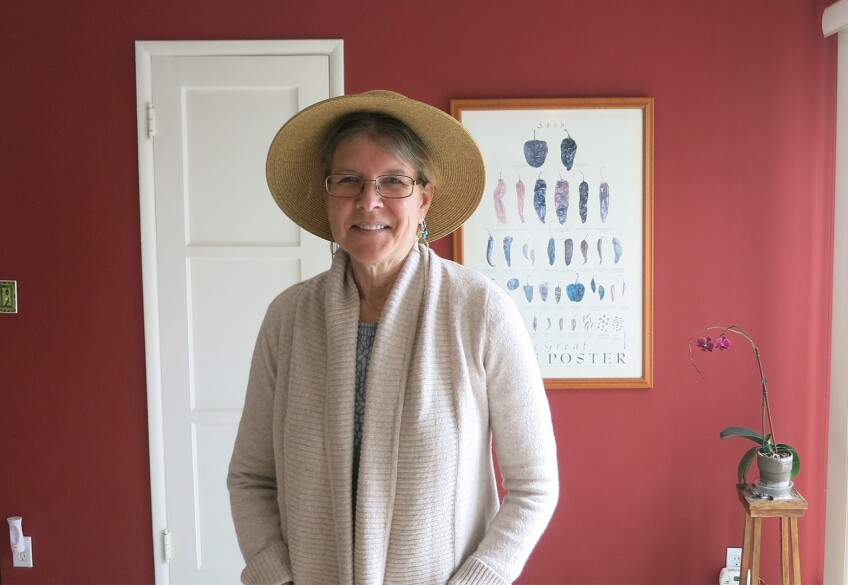L.A. County Tests Tracking Device That Helps Locate Alzheimer's Patients

Two deputies from the Los Angeles County Sheriff’s Department walk slowly along the edge of a chain-link fence. They are simulating the search for a missing 12-year-old autistic boy.
"We are by the baseball field,” said Deputy John O’Hara over a police radio. In his hand is a silver box with winglike antennas. It looks like something out of a 1960s science fiction movie. A faint beeping eventually gets stronger. He and the deputies find the transmitter marked "Project Lifesaver" on the ground. It’s more than an elaborate scavenger hunt, since they are training to save lives.
The panic of looking for someone who might wander away is familiar to Kirk Moody. Two years ago Moody’s wife, Nancy Paulikas, went missing during a trip to the Los Angeles County Museum of Art. Suffering from early onset Alzheimer's disease, Nancy was separated from Moody and has been missing ever since. SoCal Connected profiled Moody’s search for his wife in an episode last year.
"I am a huge advocate for Project Lifesaver,” said Moody. He is still looking for his wife and is convinced that she might be in a nursing home or similar facility. He is currently working with the Manhattan Beach Police and the LAPD to narrow the search.
Moody’s search inspired the Bring Our Loved Ones Home Task Force. The group focused on bridging the gaps across the county when it came to looking for missing people with impaired memory.

In February, the Los Angeles County Board of Supervisors approved the Bring Our Loved Ones Home Initiative. It outlines 17 strategiesto prevent and respond to wandering among those suffering from Alzheimer's, dementia, autism and other memory related impairments. As part of this initiative, the county has spent $30,000 on the receivers and transmitters for Project Lifesaver, which officially launches as a yearlong pilot project in September.
More on the Impact of Alzheimer's Disease
The program gives people who might be at-risk of wandering a bracelet with a radio transmitter. This helps law enforcement track them if they go missing. The county Workforce Development, Aging and Community Services and Sheriff's departments intend to distribute at least 130 bracelets.
Across the country Alzheimer’s and autism rates are on the rise.
Currently there are 5 million people who suffer from Alzheimer’s and by 2050 there could be as many as 16 million, according to the Alzheimer’s Association.
The Centers for Disease Control and Prevention reports that 1 in 59 children will be diagnosed with autism.
According to the California Department of Justice, 2,030 adults went missing last year because of physical or mental limitations such as Alzheimer's. Last year, the LA County Sheriff’s Department Missing Persons Unit recorded 333 cases of voluntary wandering and so far this year 128.
"In the event that a person wanders, if law enforcement is called, we can respond with our receivers, we tune it to the frequency that the wearer had, and it can pick up the pulsing sound,” said Mental Evaluation Team Lt. John Gannon.
During the weeklong training, sheriff’s deputies get a series of real life scenarios to practice using the technology to find people. With each exercise they start at the last known location of the missing person and then fan out. The transmitters’ radio frequency can be detected from about quarter-mile away on the ground and about 3 miles away from the air.
In one scenario the response team in a helicopter was able to narrow the search field for deputies on the ground. Then two ground teams systematically conducted a grid search.
"Old-fashion police work still helps," said Sgt. Richard Bojorquez, but using the technology along with coordinated ground efforts helps to find a missing person faster. In about 15 minutes they narrow the search to a Home Depot. There the sergeant gets out on foot with the receiver and eventually finds the wanderer inside the Home Depot.
Project Lifesaver Chief of Operations Paul Ballance described the radio frequency as better than GPS, which is based on satellite technology and could fade in and out, similar to cell phone reception. He said that there is no loss of signal with the transmitters.
The deputies were able to find people in buildings, parking structures, and busy stores.
During the training many of the scenarios were resolved within 30 minutes. Gannon hopes that once the program is in place deployment of deputies trained with the Project Lifesaver equipment can start as soon as a 911 call is received. Eventually all the people in the Mental Evaluation Team will be trained on the equipment. Members are spread throughout the county to ensure the fastest response time possible.
Each transmitter will be registered with the Sheriff’s Department and will have its own frequency. The battery life for each is about 30 to 60 days.

"It will go a very long way to keeping people safe and improving the quality of life for caregivers," said Kate Movious, head of Autism Interaction Solutions. She championed the successful implementation of the Project LIfesaver program with the Glendale Police Department and was part of the Bring Our Loved Ones Home Task Force.
Like Moody, this issue hits close to home for Movious. Her son Aiden has autism and has run away.
"Aiden never wanders. He sprints. He is a runner,” said Movious. Though her son doesn’t wear a bracelet because he doesn’t like to wear things on his arm she appreciates the impact wearing a bracelet can have on a family.
"It works," said Bojorquez. "We’re going to find people."



